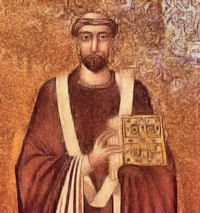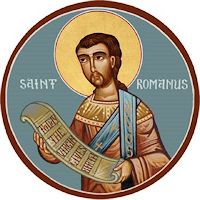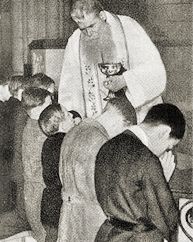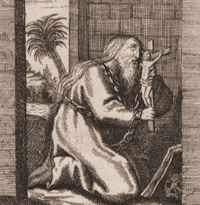Lent: February 28th
Tuesday of the First Week of Lent
Other Commemorations: St. Hilary, Pope (RM); St. Romanus of Condat, Abbot (RM); Bl. Daniel Brottier (RM)
» Enjoy our Liturgical Seasons series of e-books!
The readings and propers of the Mass shows the Church's constant effort to acquaint us with the teaching of her Founder, and to strengthen us to follow and live his teachings. Mere formalism and externalism are of no value in the religion of Christ. God demands of his people a worship in spirit and in truth, and a conversion which comes from the heart.
Lent is a time set apart to seek the Lord. It is a special time of divine mercy and grace. The Church, acting as God's prophet, calls us to return to the Lord by true penance. The word of God which is sown so abundantly during Lent should grow and bear fruit in us if we have really prepared ourselves by fasting and discipline of the flesh. —St. Andrew Bible Missal
Today the Roman Martyrology commemorates St. Hilary (d. 468), pope from 461 to 468 and guardian of Church unity, St. Romanus of Condat (390-465) who founded the abbeys of Condat and Leuconne, and the convent of La Beaume, among others and Blessed Daniel Brottier (1876-1936), a member of the Congregation of the Holy Ghost whose work included helping orphans.
Meditation—Tuesday of the First Week of Lent:
In the liturgical texts for today is hidden the mystery of the Mother of God, intimately connected with that of the incarnation of the Son of God. Let us look at the texts, and begin with the reading from the prophet Isaiah.
So shall my word be that goes forth from my mouth: it shall not return to me empty (55, 11)
When the prophet Isaiah made this affirmation, it was not at all to bring out something merely trivial, but rather a contradiction of what might be expected. For this passage belongs certainly to the story of the passion of Israel, where we read that God’s appeals to his people were continually defeated and that his word invariably remained fruitless, while God appears seated astride history, but not as a conqueror. For everything happened as a sign: the crossing of the Red Sea, the blossoming of the period of the Kings, the return of Israel to their country out of exile, all this now fades away. God’s seed in the world seems to give no results. The prophecy, therefore, however wrapped in obscurity, is an encouragement to all those who, in spite of everything continue to believe in the power of God, convince that the world is not just rocky soil in which the seed cannot find room to grow, but certain that the soil will not always be only a thin layer on the surface from which the birds day by day peck out suddenly what seed has there fallen upon it. (cf. Mk 4,1-9).
For us Christians an affirmation of this kind has the ring of the promised coming of Jesus Christ, thanks to which the word of God has now truly penetrated into the earth and has become bread for us all: seed which bears fruit through the ages, a fruitful response in which God’s discourse has taken root in this world in vital fashion. It is difficult to find elsewhere the mystery of Christ allied to that of Mary in a form as clear and condensed as in the perspective of this promise: for when it affirms that the word, or better the seed, bears fruit, it means to say that it does not fall on the ground to rebound like a ball, but that instead it penetrates deeply into the soil to absorb the moisture there and transform it into itself, truly producing something new, transubstantiating that same earth into fruit. The grain does not remain alone: this is part of the fertility mystery of the earth—Mary, the holy soil of the Church, as the Fathers fittingly call her, belongs to Christ. The mystery of Mary signifies in this connection that the word does not remain alone; rather it assumes the other, the earth, into itself; in the earth of the Mother the word becomes man, and now, mingled with the soil of the whole of humanity, it can return again to God.
The Gospel on the other hand seems to be speaking of something quite different. Here it is a question of our mode of prayer, its correct form, its proper content, the way to comport ourselves, and genuine recollection: not so much therefore of what it is for God to do, but of how we ought to act before him. In reality the two readings are interdependent; we might say that in the Gospel we come now to see how it is possible for human beings to become a fertile field for the word of God. This they can become by preparing those elements by which a life can grow and mature. They attain this end by themselves living from these elements, thus transforming themselves, being impregnated with the word, in the word, immersing their life in prayer and therefore in God.
So this Gospel, then, accords with the introduction to the Marian mystery given by Luke, when in more than one place he says of Mary that she ‘kept’ the word in her heart (2,19; 2,51). Mary united in herself the various currents in Israel; in her prayer she bore within herself the suffering and the greatness of that history, to convert it into a fertile land for the living God. To pray undoubtedly means much more, as the Gospel tells us, than speaking without reflection, merely mouthing words. To be a field for the word means to be earth which allows itself to be absorbed by the seed, which assimilates itself to the see, renouncing itself so as to make the seed germinate. With her motherhood Mary transfused into it her very substance, body and soul, so that a new life might come forth. The saying about the sword which would pierce her soul (Lk 2,35) has a much greater and more profound meaning: Mary makes herself completely available as the soil, she allows herself to be used and consumed so as to be transformed into him, who has need of us in order to become the fruit of the earth.
In the Collect for today we are called upon to have a longing desire for God. The Fathers of the Church maintain that to pray is nothing else than to turn into a longing desire for the Lord. In Mary this petition is heard: she is, may I say, a vessel of desire in whom life becomes prayer, and prayer life. St. John has wonderfully alluded to such a process of transformation while not calling Mary by name in his Gospel. He refers to her solely as the mother of Jesus. She in a certain sense set aside whatever in her life was personal, so as to be uniquely at the disposal of the Son; and it is precisely in this that Mary realised her personality.
I think that such links between the mystery of Christ and that of Mary put before us by today’s Readings are of great importance for the Western activistic mentality, which has reached its peak in our age. For to our way of thinking the principle of domination alone still has value.: action, production, planning the world and, along with that, reconstructing it by ourselves, without owing anything to anybody but confidently relying on our own resources. With such a mentality, then, it is not by chance that we have more and more separated Christ from his mother, without taking account of how Mary as his mother, could signify something indispensable for theology and for faith. The whole of this way of considering the Church thus starts out from an erroneous way of thinking. We may even ourselves consider it as a technical product which we intend to programme cleverly and bring to realization with a tremendous expenditure of energy. We wonder whether that can happen which St. Louis-Marie Grignon de Montfort appended to a passage from the prophet Haggai “You have done much but nothing has come of it” (1,6). “If doing takes the upper hand, becoming autonomous, then those things which are not manufactured, but are living and need to mature, will no longer be able to exist.”
We want to get out of this one-sided outlook belonging to Western activism in order not to degrade the Church to a product of our doing and planning. The Church is not a finished artefact but always living from God, needing to develop and achieve maturity. For this she requires the Marian mystery, just as she herself is the mystery of Mary. She can train herself to that fecundity only if she submits to that sign; only then does she become holy soil for the word. We should adopt the symbol of the fertile soil, we should become people who hope, harvesting their own inner lives, persons who, deep within their prayer, their longing and their faith, make room for growth.
—Cardinal Joseph Ratzinger (Pope Benedict XVI), Journey Towards Easter
St. Hilary
 To replace a man like Leo was not easy, but the next pope was a man after Leo's heart, the archdeacon Hilary. Hilary was a Sardinian who had joined the Roman clergy and had been sent by St. Leo as one of the papal legates to the council at Ephesus in 449. This council, intended to settle the Monophysite affair, got out of hand. Packed with Monophysites and presided over by Dioscorus, the patriarch of Alexandria, the assembly refused to listen to the protests of the papal legates. Dioscorus steam-rollered through the council a condemnation of the orthodox and saintly Flavian, patriarch of Constantinople, and an approval of the Monophysite leader Eutyches. In vain Hilary protested. He had to fly in fear for his life and hide in a chapel of St. John the Evangelist. It was only with difficulty that he got back to Rome. No wonder St. Leo called this Ephesus council a gathering of robbers!
To replace a man like Leo was not easy, but the next pope was a man after Leo's heart, the archdeacon Hilary. Hilary was a Sardinian who had joined the Roman clergy and had been sent by St. Leo as one of the papal legates to the council at Ephesus in 449. This council, intended to settle the Monophysite affair, got out of hand. Packed with Monophysites and presided over by Dioscorus, the patriarch of Alexandria, the assembly refused to listen to the protests of the papal legates. Dioscorus steam-rollered through the council a condemnation of the orthodox and saintly Flavian, patriarch of Constantinople, and an approval of the Monophysite leader Eutyches. In vain Hilary protested. He had to fly in fear for his life and hide in a chapel of St. John the Evangelist. It was only with difficulty that he got back to Rome. No wonder St. Leo called this Ephesus council a gathering of robbers!
As pope, Hilary worked hard to foster order in the Gallic hierarchy. When a certain Hermes illegally made himself archbishop of Narbonne, two Gallic delegates came to Rome to appeal to Pope Hilary. He held a council at Rome in 462 to settle the matter. He also upheld the rights of the see of Arles to be the primatial see of Gaul. From Spain also came appeals of a similar nature. To settle these Hilary held a council at Rome in 465. This is the first Council at Rome whose acts have come down to us. According to the "Liber Pontificalis" he sent a letter to the East confirming the ecumenical councils of Nicaea, Ephesus, and Chalcedon, and the famous dogmatic letter of his predecessor St. Leo to Flavian. He also publicly in St. Peter's rebuked the shadow-emperor Anthemius for allowing a favorite of his to foster heresy in Rome.
St. Hilary deserves great credit for his work in building and decorating churches in Rome. Of especial interest is the oratory he built near the Lateran, dedicated to St. John the Evangelist. The Pope attributed his escape from the wild Monophysites at Ephesus to the intercession of the Beloved Disciple, and to show his gratitude he built this beautiful oratory. Over its doors may still be seen the inscription, "To his deliverer, Blessed John the Evangelist, Bishop Hilary, the Servant of Christ." Hilary built two more churches and spent freely in decorating still others. The gold and silver and marble used so lavishly by this Pope in adorning the Roman churches indicate that the wealthy families of Rome must have saved something from the grasping hands of Goths and Vandals.
St. Hilary died on February 29. His feast is celebrated on February 28.
—Excerpted from Defending the Faith
Highlights and Things to Do:
- Read more about St. Hilary or Hilarus:
- St. Hilary's relics are buried in Basilica Papale di San Lorenzo fuori le mura (Papal Basilica of St. Laurence Outside the Walls.
Saint Romanus of Condat
 Romanus at thirty-five years of age left his relatives and spent some time in the monastery of Ainay at Lyons, at the great church at the conflux of the Saône and Rhone which the faithful had built over the ashes of the famous martyrs of that city; for their bodies being burned by the pagans, their ashes were thrown into the Rhone, but a great part of them was gathered by the Christians and deposited in this place.
Romanus at thirty-five years of age left his relatives and spent some time in the monastery of Ainay at Lyons, at the great church at the conflux of the Saône and Rhone which the faithful had built over the ashes of the famous martyrs of that city; for their bodies being burned by the pagans, their ashes were thrown into the Rhone, but a great part of them was gathered by the Christians and deposited in this place.
Romanus a short time after retired into the forests of Mount Jura, between France and Switzerland, and fixed his abode at a place called Condate, at the conflux of the rivers Bienne and Aliere, where he found a spot of ground fit for culture, and some trees which furnished him with a kind of wild fruit. Here he spent his time praying, reading, and laboring for his subsistence.
Lupicinus, his brother, came to him sometime after in company with others, who were followed by several more, drawn by the fame of the virtue and miracles of these two Saints. Their numbers increasing, they built several monasteries, and a nunnery called La Beaume, which no men were allowed ever to enter, and where St. Romanus chose his burial-place.
The brothers governed the monks jointly and in great harmony, though Lupicinus was the more inclined to severity of the two. Lupicinus used no other bed than a chair or a hard board; never touched wine, and would scarcely ever suffer a drop either of oil or milk to be poured on his pottage. In summer his subsistence for many years was only hard bread moistened in cold water so that he could eat it with a spoon. His tunic was made of various skins of beasts sewn together,. with a cowl; he used wooden shoes, and wore no stockings unless when he was obliged to go out of the monastery.
St. Romanus died about the year 460, and St. Lupicinus survived him almost twenty years.
Patronage: against insanity; against mental illness; drowning victims; mentally ill people
Highlights and Things to Do:
- Read more about St. Romanus of Condat:
- St. Romanus' relics are now in Abbey of Saint-Romain-de-Roche.
Bl. Daniel Brottier
 Blessed Daniel Brottier was a French Spiritan born in France in 1876 and ordained priest 1899. His zeal for spreading the Gospel beyond the classroom or the confines of France made him to join the Spiritan Congregation.
Blessed Daniel Brottier was a French Spiritan born in France in 1876 and ordained priest 1899. His zeal for spreading the Gospel beyond the classroom or the confines of France made him to join the Spiritan Congregation.
He was sent to Senegal, West Africa. After eight years there, his health suffered and he went back to France where he helped raise funds for the construction of a new cathedral in Senegal.
At the outbreak of World War I Daniel became a volunteer chaplain. He attributed his survival on the front lines to the intercession of Saint Therese of Lisieux, and built a chapel for her at Auteuil when she was canonized.
After the War he established a project for orphans and abandoned children "the Orphan Apprentices of Auteuil" in the suburb of Paris.
He gave up his soul to God on the 28th of February, 1936 and was beatified only 48 years later in 1984 by Pope John Paul II.
—Excerpted from Evangelizo.org
Highlights and Things to Do:
- Read more about Bl. Daniel Brottier:
- Read more about Brother Dan:
- Bl. Daniel was a member of the Congregation of the Holy Spirit which under his management took up the task of helping orphans after World War I.
- Bl. Daniel was buried at the Chapelle Sainte-Thérèse de la fondation d'Auteuil. In 1962 when his cause was being promoted, his remains were found to be completely intact.
- Bl. Daniel had great devotion to St. Thérèse the Little Flower.






